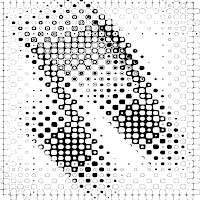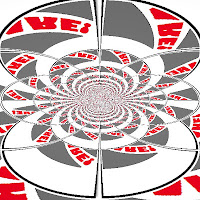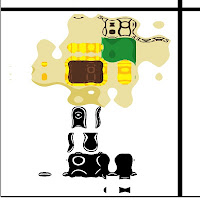Not the Same Old 4th of July Side Dishes
We'll assume you have all the main courses figured out for your 4th of July cookout (if not, we can help), but just in case you're still looking for some side dishes, here are a few out of the ordinary ideas that should work beautifully. Just click the caption link to see the post and video. Enjoy!
Cold Broccoli Salad |
Peach and Escarole Salad |
Apple Jicama Coleslaw |
Boston Baked Beans |
 |
Succotash Salad |
Pickled Grilled Vegetables |
"Eye to Eye" versus Richard Dawkins
by Salman Hameed
Dawkins recently gave a psychedelic presentation of memes, and in particular focusing on internet memes. I'm sure one of the goals was to make the presentation itself into a viral video. Here it is - and watch it transform around the 5 minute mark:
Well, when it comes to internet memes, I think Taher Shah from Pakistan has a lesson or two about that. Here is his mesmerizing video "Eye to Eye" which has gone viral. It is all in English and as far as I can tell, he did not intend to be a satire. He really does like eyes - yours, his, others' - and would like to make love with his full spectrum eyes.
No seriously - you have to spend 5 minutes and watch this video (with your own eyes!):
eye to eye by taher shah from waseem ullah Qureshi on Vimeo.
And while we are at it, we can't go without watching the video of One-Pound Fish - another Pakistan connection - that became a sensation a few months ago (here is the NPR story about this song and link to where it all started):
Dawkins recently gave a psychedelic presentation of memes, and in particular focusing on internet memes. I'm sure one of the goals was to make the presentation itself into a viral video. Here it is - and watch it transform around the 5 minute mark:
Well, when it comes to internet memes, I think Taher Shah from Pakistan has a lesson or two about that. Here is his mesmerizing video "Eye to Eye" which has gone viral. It is all in English and as far as I can tell, he did not intend to be a satire. He really does like eyes - yours, his, others' - and would like to make love with his full spectrum eyes.
No seriously - you have to spend 5 minutes and watch this video (with your own eyes!):
eye to eye by taher shah from waseem ullah Qureshi on Vimeo.
And while we are at it, we can't go without watching the video of One-Pound Fish - another Pakistan connection - that became a sensation a few months ago (here is the NPR story about this song and link to where it all started):
السنة النبوية في فتح الباري
رابط الحفظ
الكتاب كاملاً
روابط منفصلة لكل جزء
No-Bake Cheesecake Flag Cake – Let Your Fruit Flag Fly!
I’ve been avoiding doing a no-bake cheesecake recipe, despite the many food wishes for it, simply because I love the dense, rich texture of the traditional baked version so much that it seems almost a crime to do something like this instead.
That’s a silly attitude, as these are two entirely different desserts, and since I needed a white canvas on which to demo the fruity, 4th of July flag design seen herein, I decided to go for it. The fact that we just had our first real heat wave of the summer didn’t hurt either.
That you can make this lovely, sweet treat without turning on the oven is probably enough of a reason to give this serious consideration. Besides the taste and texture, I think your guests will enjoy the iconic stars and stripes design provided by the fresh blueberries and strawberries.
Everyone knows that if you eat enough fresh fruit with a dessert, it cancels out the negative effects from the sugar and the fat, or at least that’s what I’ve always assumed. Anyway, there is no greater tribute an American cook can pay to this great democracy of ours, than to make a shortcut dessert that looks like our flag. USA! USA! USA! I hope you give this a try soon. Enjoy!
Ingredients for 12 portions:
For the crust:
1 1/2 cups finely crushed graham cracker crumbs
6 tbsp melted butter
1/4 cup white sugar
2 tbsp unsweetened cocoa powder
For the filling:
2 cups (1 pound) cream cheese (I used half regular and half mascarpone)
2 tsp grated lemon zest
2 tsp lemon juice
1 tsp vanilla extract
1 1/4 cups cold heavy whipping cream (36% fat)
Beyond the Religion-Secular divide in Occupy Gezi and a paper on Turkish University Students
by Salman Hameed
The unrest in Turkey continues. I have two articles below. The first one deals looks beyond the usual secular-religious divide when discussing Turkey, and the second looks at the role of social identity in the formation of attitudes towards Turkish foreign policy. First here is an article by Ateş Altınordu on The Immanent Frame:
Here is an interesting article in the latest issue of International Journal of Middle East Studies: Social Identity and Attitudes toward Foreign Policy: Evidence from a Youth Survey in Turkey by Sabri Ciftci (you probably will need subscription to access the full article). Here is the abstract:
Second, this is how these students define themselves in terms if their national and international identity:
But when you look at their perceptions of Turkey's future, most of them see it in terms of EU and/or the Turkic Republics:
Ciftci concludes this part of the results as follows:
_________________
Ceftci, S. (2013), Social Identity and attitudes toward foreign policy: Evidence from a youth survey in Turkey, International Journal of Middle East Studies / Volume 45 / Issue 01 / February 2013, pp 25-43. DOI: http://dx.doi.org/10.1017/S0020743812001249
The unrest in Turkey continues. I have two articles below. The first one deals looks beyond the usual secular-religious divide when discussing Turkey, and the second looks at the role of social identity in the formation of attitudes towards Turkish foreign policy. First here is an article by Ateş Altınordu on The Immanent Frame:
Does the actual picture of Occupy Gezi confirm the existence of a deep fault line between secular and religious citizens that Erdoğan and the New York Times alike posit? It is true that most religious-conservative citizens are not participating in Occupy Gezi, and it is rather safe to assume that many maintain their support for the AKP and for Erdoğan himself. However, there are many significant crosscurrents that complicate this picture. First, Occupy Gezi brings together many different groups, including Kemalists, liberal-minded secular citizens, environmentalists, revolutionary socialists, anarchists, feminists, LGBT groups, highly politicized activists, and young people who simply oppose police brutality and the government’s authoritarian policies. As opposed to what Erdoğan has repeatedly implied, Occupy Gezi is fundamentally different from the Republican Rallies of 2007, which were organized by militant secularist organizations and aimed to prepare the ground for a military coup against the AKP government. While Kemalist groups may chant “we are the soldiers of Mustafa Kemal” during the demonstrations, calls for the military to intervene in the political process are hardly ever heard. Moreover, all participants in the movement seem to share a general respect for religious citizens.
On June 4, the day after newspapers close to the AKP started to advance Erdoğan’s agenda by depicting Occupy Gezi as an anti-religious movement, movement participants announced that alcohol should not be consumed on the park’s premises that day as a sign of respect for the Miraç Kandili, a Muslim holiday commemorating the prophet’s ascent to heaven. Throughout the day, volunteers offered thousands of traditional kandil bagels to anyone entering the park.
More importantly, while constituting a minority in the movement, many pious Muslims, AKP voters, and some Islamic organizations have participated in the protests. One social justice-oriented Islamic group in particular, Anti-Capitalist Muslims, has been part of the campaign against the destruction of the park from the very beginning and has a major presence in the movement.And here is the broader outlook:
The liberation theology of the Anti-Capitalist Muslims shows that it is difficult to categorize the religious circles in Turkey as a single, uniform bloc under the unbreakable spell of Erdoğan’s AKP. The same is true for secular people, many of whom have learned to respect the religious practices of their fellow citizens, including their right to wear headscarves in public institutions. The transformative potential that emerges from the respectful coexistence of different political orientations and social groups in Occupy Gezi should not be underestimated, both in the park and in the movement more broadly. As soccer fans who use homophobic epithets in their slogans against Erdoğan are learning from the LGBT groups in the park why this is problematic, and as many Turks in the movement increasingly seem to empathize with the Kurds now that they are also experiencing indiscriminate police violence and witnessing the indifference of the mainstream media, a transformation is likewise taking place in the relationship between secular and religious citizens who together protest the authoritarian policies of the government and the violent practices of the police. The careful respect that the mostly secular participants in the movement exhibited on Miraç Kandili, voluntarily giving up drinking in public—although they vigorously defend their right to drink in public—and Eliaçık’s statement of solidarity with alcohol drinkers are manifestations of this rapprochement.
What is happening within the confines of the Gezi Park has its limits, of course, in terms of its wider ramifications, but it is indicative of larger political learning processes in a society increasingly suffering from the authoritarian tendencies of the government, Erdoğan’s paternalistic style of rule, and the disproportionate use of force by the police against groups as diverse as soccer fans, university students, and environmental activists.Read the full article here.
Here is an interesting article in the latest issue of International Journal of Middle East Studies: Social Identity and Attitudes toward Foreign Policy: Evidence from a Youth Survey in Turkey by Sabri Ciftci (you probably will need subscription to access the full article). Here is the abstract:
This paper focuses on the relationship between social identity based on national, religious, or international affiliations and attitudes toward foreign policy in the Turkish context. Evidence is drawn from an original survey conducted among university students in Turkey. The results show that students' social identity has a significant correlation with their perceptions of foreign policy. Most Turkish university students provide conditional support for the new directions in Turkey's foreign policy, but those with an Islamic identity appear to be more supportive of the Adalet ve Kalkınma Partisi's (Justice and Development Party) policies. Most university students believe that Turkey's future lies in the European Union and the Central Asian Turkic republics rather than in the Middle East. Overall, the perceptions of educated youth toward foreign policy are shaped by both social identity and their conceptions of national interest.His sample of 800 university students from Cumhuriyet University in central Turkey span a broad spectrum of political, ethnic, and religious identities. So couple of things I wanted to highlight. First, it seems that less than half of these students think that Turkey should be a member of the EU:
Second, this is how these students define themselves in terms if their national and international identity:
But when you look at their perceptions of Turkey's future, most of them see it in terms of EU and/or the Turkic Republics:
Moving beyond these general perceptions, the young and educated segment of the Turkish electorate believes that Turkey's future lies in the EU or the Turkic republics. Only a small fraction of the respondents has an orientation toward the Middle East or the Islamic world. It appears that individuals develop attitudes differently about the goals and the future of foreign policy. When it comes to the former, most educated youth appear to emphasize foreign policy strategies that are more in line with a nationalistic perception of state identity. This view is compatible with Davutoğlu's strategic depth approach, which favors a multidimensional policy exploiting multiple identities. Since Davutoğlu has implemented his foreign policy vision as Turkish foreign minister, the finding shows that university students carry orientations that are in line with this theoretically inspired policy framework. Furthermore, students' orientations appear to be in line with the scholarly approach explaining foreign policy activities with notions such as balance of power, geopolitics, and economic interests rather than with accounts describing the new directions in Turkish foreign policy as an axis shift or Middle Easternization.This paper was published before the Gezi protests. Nevertheless, it provides an interesting window into the identity perceptions of Turkish university students.
_________________
Ceftci, S. (2013), Social Identity and attitudes toward foreign policy: Evidence from a youth survey in Turkey, International Journal of Middle East Studies / Volume 45 / Issue 01 / February 2013, pp 25-43. DOI: http://dx.doi.org/10.1017/S0020743812001249
Announcing the 2013 Lean Startup Conference
We’re excited to announce the 2013 Lean Startup Conference, December 9 - 11 in San Francisco. As the Lean Startup movement grows and matures, the conference does, too, this year expanding and changing in a number of ways—based almost entirely on things that our attendees have asked for.
We’ll talk in a minute about some of the new features of the conference, but first, let’s look at the conference themes. This year, in addition to featuring the types of talks you’ve found useful in the past—founder stories, MVP case studies, pivot discussions—we’re also layering in new topics that you’ve told us you’re grappling with, including:
In order to offer a deeper dive on the topics most useful to you, we’ve added a day to the conference. So this year, on both December 9 and 10, we’ll have a mix of keynotes and breakouts with targeted how-to talks. Breakouts are new for The Lean Startup Conference, representing one of the strongest pieces of feedback we’ve gotten: you want sessions that provide more in-depth advice about strategies, tactics and tools you can apply the day you get home from the conference. On December 11, an optional extra day for attendees, we’ll also offer half-day workshops on select topics and site visits to startups around San Francisco. Last year, that extra day of the conference included some of the elements you liked most. On December 12 and 13, we’re partnering again with Lean Startup Machine for two additional (and intense) days of applied learning.
One of the other things we’ve heard loud and clear is that you want more ways to meet other attendees at the conference. This year, we’ll not only provide a useful app to help with just that problem, but we’re also baking into the program interesting networking and mentoring sessions. We’ll have more detail on those events later this summer, but do know that we’re putting considerable effort into shaping that aspect of the conference.
Somehow, we’re more than halfway through this post, and we haven’t yet mentioned our incredible speakers. Again, taking a cue from your feedback, we’ve sought out super-useful stories from people you don’t already know from the Lean Startup speaking circuit (like Netia McCray, Valerie Gofman and Ari Gesher, to name just a few), and their talks form the core of the program. We’re also bringing back a few of our most popular speakers from last year (Stephanie Hay, Diane Tavenner and more), asking them to shed new light on the epiphanies they shared in 2012. And, of course, we’re sprinkling in the best Lean Startup experts—the people who deliver fresh, relevant advice every time out (Kent Beck, Alistair Croll, Laura Klein, we could go on here). Here’s the coolest thing: our site today lists just about a third of the speakers and mentors we’re bringing to you this year—so it’s starting off great, and it’s going to get better.
One other piece of feedback you gave us: last year's venue was too crowded. We've upgraded to a large theater, the Nob Hill Masonic Center, and the neighboring Fairmont Hotel, which will give us a lot more elbow room. Should be more like flying first-class, less like coach.
What does a ticket include? The General Admission Pass includes the two-day conference (December 9 - 10), and access to events those days for connecting with other attendees. The Gold Pass gets you those things, plus a third day of hands-on workshops and startup site visits around San Francisco (December 11). The VIP Pass includes all of that, plus Lean Startup Machine (December 12 - 13), reserved seating at the main conference, first dibs on limited seating lunches and other goodies. In addition, we’ve set aside a number of deeply discounted, no-frills scholarship passes for people who couldn’t otherwise afford to attend: students, bootstrappers and very early stage startups. If that's you, apply here.
Tickets are on sale now, and we sell them in batches: when one batch sells out, the price goes up. So the best deals are available today. Register now.
We’ll talk in a minute about some of the new features of the conference, but first, let’s look at the conference themes. This year, in addition to featuring the types of talks you’ve found useful in the past—founder stories, MVP case studies, pivot discussions—we’re also layering in new topics that you’ve told us you’re grappling with, including:
- Emerging strategies that maturing companies have tested to keep innovation at the core of their businesses
- Unexpected challenges faced by entrepreneurs implementing Lean Startup practices around the world; and
- The particular opportunities for Lean Impact among non-profit and mission-driven organizations
In order to offer a deeper dive on the topics most useful to you, we’ve added a day to the conference. So this year, on both December 9 and 10, we’ll have a mix of keynotes and breakouts with targeted how-to talks. Breakouts are new for The Lean Startup Conference, representing one of the strongest pieces of feedback we’ve gotten: you want sessions that provide more in-depth advice about strategies, tactics and tools you can apply the day you get home from the conference. On December 11, an optional extra day for attendees, we’ll also offer half-day workshops on select topics and site visits to startups around San Francisco. Last year, that extra day of the conference included some of the elements you liked most. On December 12 and 13, we’re partnering again with Lean Startup Machine for two additional (and intense) days of applied learning.
One of the other things we’ve heard loud and clear is that you want more ways to meet other attendees at the conference. This year, we’ll not only provide a useful app to help with just that problem, but we’re also baking into the program interesting networking and mentoring sessions. We’ll have more detail on those events later this summer, but do know that we’re putting considerable effort into shaping that aspect of the conference.
Somehow, we’re more than halfway through this post, and we haven’t yet mentioned our incredible speakers. Again, taking a cue from your feedback, we’ve sought out super-useful stories from people you don’t already know from the Lean Startup speaking circuit (like Netia McCray, Valerie Gofman and Ari Gesher, to name just a few), and their talks form the core of the program. We’re also bringing back a few of our most popular speakers from last year (Stephanie Hay, Diane Tavenner and more), asking them to shed new light on the epiphanies they shared in 2012. And, of course, we’re sprinkling in the best Lean Startup experts—the people who deliver fresh, relevant advice every time out (Kent Beck, Alistair Croll, Laura Klein, we could go on here). Here’s the coolest thing: our site today lists just about a third of the speakers and mentors we’re bringing to you this year—so it’s starting off great, and it’s going to get better.
One other piece of feedback you gave us: last year's venue was too crowded. We've upgraded to a large theater, the Nob Hill Masonic Center, and the neighboring Fairmont Hotel, which will give us a lot more elbow room. Should be more like flying first-class, less like coach.
What does a ticket include? The General Admission Pass includes the two-day conference (December 9 - 10), and access to events those days for connecting with other attendees. The Gold Pass gets you those things, plus a third day of hands-on workshops and startup site visits around San Francisco (December 11). The VIP Pass includes all of that, plus Lean Startup Machine (December 12 - 13), reserved seating at the main conference, first dibs on limited seating lunches and other goodies. In addition, we’ve set aside a number of deeply discounted, no-frills scholarship passes for people who couldn’t otherwise afford to attend: students, bootstrappers and very early stage startups. If that's you, apply here.
Tickets are on sale now, and we sell them in batches: when one batch sells out, the price goes up. So the best deals are available today. Register now.
Activity: All Mixed Up
For this game, I have used various filters to scramble the images representing several primary songs we have learned.
If your primary is already familiar with the images from the Matching Game, you may print only the scrambled pictures and ask the children to guess the song each one represents. If they don't recognize the Matching Game pictures, you may print one copy of each, cut them out, tape them randomly onto the board and have the children match the pictures together.
(The link below shows only the scrambled pictures. For the originals and the names of the songs that correspond, click on the link for the Matching Game. I've left both documents in Word format so that you can delete the pictures you don't wish to use.)
Subscribe to:
Posts (Atom)































































































.jpg)





0 comments:
welcome to my blog. please write some comment about this article ^_^